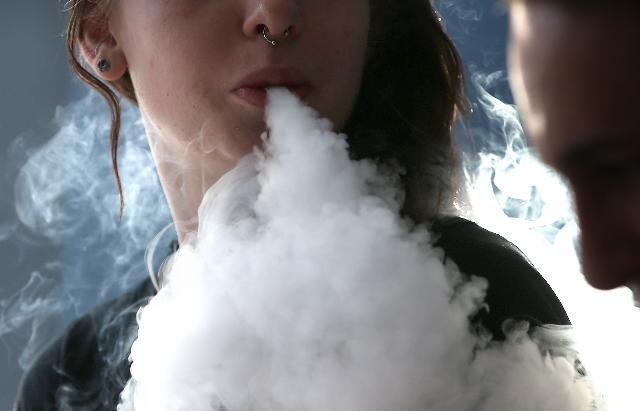Three times as many middle school and high school students used e-cigarettes in 2014 than in 2013, according to an annual survey on youth tobacco use conducted by the CDC and FDA and published yesterday.

That’s right — the number of high school students who said they had vaped at least once in the past 30 days tripled in one year, from 4.3 percent to 13.4 percent for high school students and from 1.1 percent to 3.9 percent for middle school students.
E-cigarettes are the hot new thing, said Dr. Harold J. Farber, a pediatric pulmonologist at Texas Children’s Hospital. They are hip, they are cool, they have candy flavors that appeal to young kids, and they are amazingly discreet. They also contain one of the most addictive substances that exists, and e-cigarette manufacturers are doing a great job of marketing these products to kids, Farber said,
Yet there is almost no regulation to stop them. Most states ban e-cigarette sales to minors, but that’s clearly not stopping teens from getting them, especially from online orders. The FDA proposed regulations last year but has generally been dragging its feet for years, said Farber, who calls the agency’s sluggishness on the issue unconscionable. Further, the proposed regulations do not limit advertising or flavors such as bubblegum, cherry or chocolate that attract kids.
The good news in this CDC report, as highlighted in USA Today is the continuing drop in cigarette smoking among high school students, falling below 10 percent for the first time (9.4 percent). Middle school cigarette smoking remained steady at 2.5 percent. But the combination of e-cigarettes and increasing use of hookahs threaten to undo the progress made in reducing youth cigarette smoking.
We had been seeing tobacco use substantially dropping over the last 20 years and now with the promotion of these new innovative products, we’re starting to see their use rapidly rise, Farber said. Most, if not all, kids know about them, and a great many have tried it or are trying it.
Hookah smoking nearly doubled among high school students, moving from 5.2 percent to 9.4 percent. Among middle schoolers, it increased from 1.1 percent to 2.5 percent. With the hookahs, you have not just the tobacco but the charcoal to keep it burning, and you have to inhale fairly deeply and hold it longer, Farber said. So it’s estimated that with one hookah session, you could be inhaling the amount of tobacco equivalent to what you would get from about 100 cigarettes.
While the health risks of hookahs – containing tobacco like cigarettes – are established, the safety of e-cigarettes continues to be hotly debated by vaping advocates and the research community. There is no evidence presently that they are more dangerous or as dangerous as cigarettes, but there is also too little data to conclusively determine they are safer either. A number of former smokers have become vaping advocates and swear that switching to vaping has saved their lives. The research on the effectiveness of vaping to quit smoking is mixed, though. E-cigarettes are likely at least a little less harmful than cigarettes. It’s too early, however, to have long-term data on their use, and investigations into their ingredients, such as the study I wrote about yesterday on flavorings, did not measure actual outcomes in vapers, so they can only raise questions about risks and regulation.
Being potentially less harmful than cigarettes may be great for adult smokers trying to quit and save themselves the suffering of lung cancer or emphysema. But being less harmful than cigarettes doesn’t make e-cigarettes harmless: as nicotine-containing products, they are still highly addictive, and nicotine is still a drug with health consequences.
We know that nicotine changes the brain structure and chemistry, and we know that adolescence is a time of active growth and development to the brain, Farber said. In addition, if the 2.5 million middle and high school students who tried e-cigarettes go on to become addicted, they may not break the habit by the time they start becoming parents. Nicotine has long been established as harmful to a developing fetus, negatively affecting lung development, breathing control and other autonomic functions. Nicotine exposure also increases the risk of sudden infant death syndrome after the baby’s birth and possibly of learning disabilities later on.
While the health risks of hookahs – containing tobacco like cigarettes – are established, the safety of e-cigarettes continues to be hotly debated by vaping advocates and the research community. There is no evidence presently that they are more dangerous or as dangerous as cigarettes, but there is also too little data to conclusively determine they are safer either. A number of former smokers have become vaping advocates and swear that switching to vaping has saved their lives. The research on the effectiveness of vaping to quit smoking is mixed, though. E-cigarettes are likely at least a little less harmful than cigarettes. It’s too early, however, to have long-term data on their use, and investigations into their ingredients, such as the study I wrote about yesterday on flavorings, did not measure actual outcomes in vapers, so they can only raise questions about risks and regulation.
Being potentially less harmful than cigarettes may be great for adult smokers trying to quit and save themselves the suffering of lung cancer or emphysema. But being less harmful than cigarettes doesn’t make e-cigarettes harmless: as nicotine-containing products, they are still highly addictive, and nicotine is still a drug with health consequences.
We know that nicotine changes the brain structure and chemistry, and we know that adolescence is a time of active growth and development to the brain, Farber said. In addition, if the 2.5 million middle and high school students who tried e-cigarettes go on to become addicted, they may not break the habit by the time they start becoming parents. Nicotine has long been established as harmful to a developing fetus, negatively affecting lung development, breathing control and other autonomic functions. Nicotine exposure also increases the risk of sudden infant death syndrome after the baby’s birth and possibly of learning disabilities later on.





